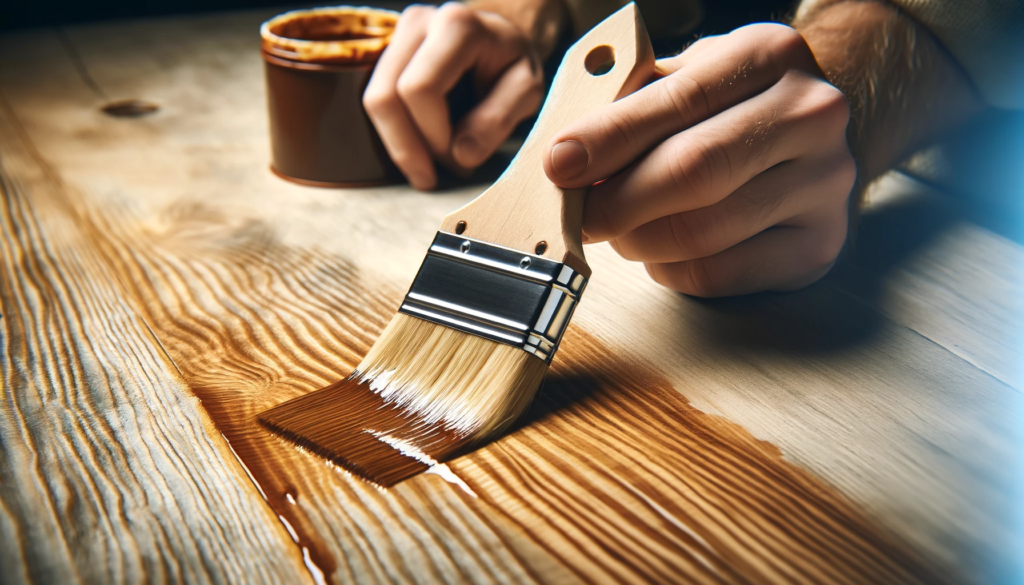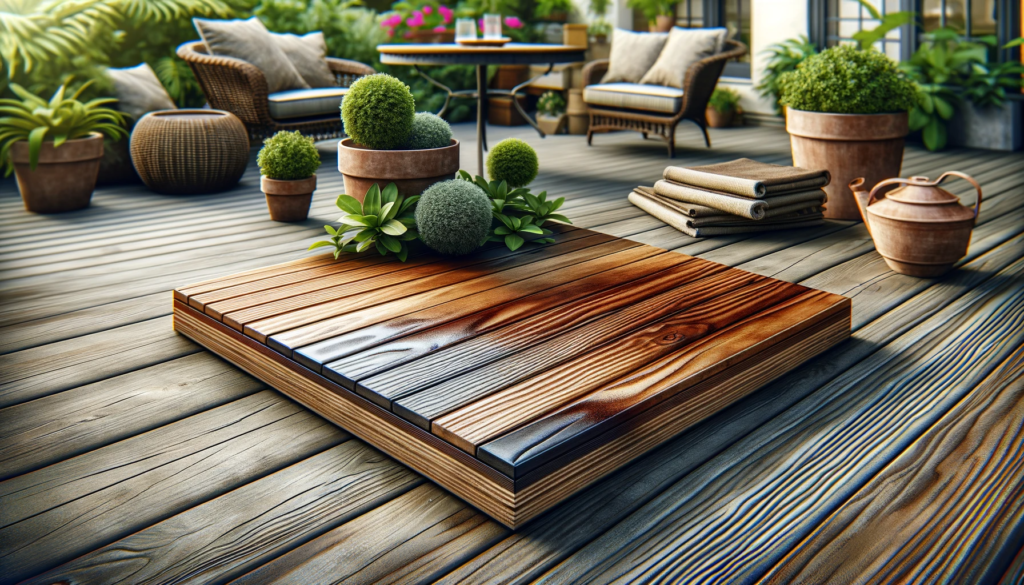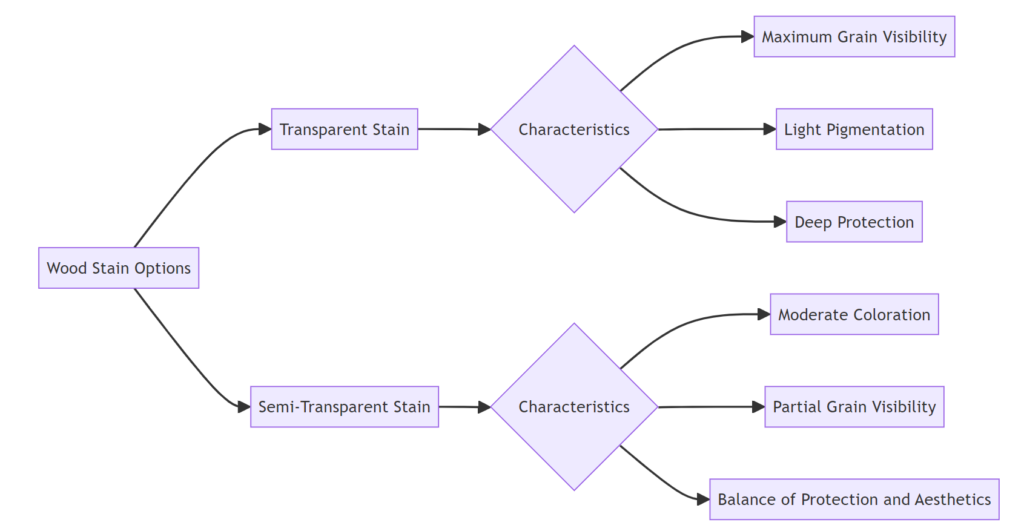Wood staining is an art that enhances the natural beauty of your wooden surfaces. The choice between transparent and semi-transparent stains is crucial, as it impacts the aesthetics and durability of your wood. Here, we delve into the specifics of each option to guide your decision.
Transparent Stains: Revealing the Wood’s True Character
Transparent stains play an essential role in highlighting the intrinsic beauty of wood. These stains are uniquely designed to penetrate deeply into the wood, providing not just a protective layer, but also ensuring that the natural grain and texture remain at the forefront of the aesthetic.
Ideal for high-quality lumber that boasts a strong, natural grain, transparent stains are the go-to for those looking to preserve and accentuate the wood’s original character. They contain a light pigmentation that gently enhances the wood’s color without overpowering it.
This subtlety is what makes transparent stains a favorite among wood enthusiasts who appreciate the purity of untreated wood yet seek the durability and protection that a stain provides. By choosing a transparent stain, you are opting to let the wood’s true personality shine through, creating a look that is as natural as it is enduring.

Key Features of Transparent Stains
Maximum Grain Visibility
Transparent stains are celebrated for their ability to maximize grain visibility. This feature is paramount for those who wish to showcase the unique patterns and textures inherent in their wood. By allowing the natural intricacies of the wood grain to remain prominently visible, transparent stains create a finish that is both authentic and visually striking. This characteristic is especially beneficial for woods with pronounced and beautiful grain patterns, ensuring that these natural artworks are not hidden but rather highlighted.
Light Pigmentation
The light pigmentation in transparent stains delicately tints the wood, subtly enhancing its natural color without overwhelming it. This minimalistic approach to coloring is ideal for preserving the original hue of the wood while offering a slight enhancement. The light pigmentation ensures that the stain merges seamlessly with the wood, providing a cohesive and natural look. This feature is particularly valuable for those who prefer a more understated and organic aesthetic, where the focus is on celebrating the wood’s inherent beauty.
Deep Penetration for Long-Lasting Protection
One of the most significant advantages of transparent stains is their ability to penetrate deeply into the wood. This deep penetration does more than just superficially coat the surface; it ingrains the stain into the wood fibers, providing robust and long-lasting protection. This deep-seated protection guards against environmental elements such as moisture, UV rays, and temperature fluctuations, thereby preserving the wood’s integrity and prolonging its lifespan. The result is not only a wood surface that maintains its aesthetic appeal over time but also one that stands up to the rigors of both indoor and outdoor environments.
Semi-Transparent Stains: Balancing Color and Texture
Semi-transparent stains represent the perfect equilibrium between adding a hint of color and maintaining the natural texture of the wood. These stains are expertly formulated to impart a moderate level of pigmentation, thus enriching the wood’s color while still allowing its inherent grain and character to shine through.
This balance makes semi-transparent stains highly versatile, suitable for a variety of wood types, including those with slight imperfections or a less pronounced grain. The stain’s translucency plays a key role in this versatility, offering a spectrum of color that enhances, rather than masks, the wood’s natural beauty. Ideal for those seeking to subtly shift the wood’s color tone while preserving its textural details, semi-transparent stains are a go-to for achieving a harmonious blend of color enhancement and textural authenticity.
They provide a solution that celebrates the wood’s original charm while introducing a customizable color aspect, making them a popular choice for both interior and exterior wood applications.

Key Features of Semi-Transparent Stains
Moderate Coloration
Semi-transparent stains are characterized by their moderate coloration, a feature that delicately infuses wood with a touch of color while preserving its natural charm. This moderate coloring approach strikes an ideal balance, neither overpowering the wood’s original hue nor leaving it untouched. It subtly enhances the wood’s color, bringing a fresh and revitalized appearance. This level of coloration is perfect for those who desire a noticeable yet understated change in their wood’s appearance, providing a gentle transformation that respects the wood’s inherent beauty.
Partial Grain Visibility
The beauty of semi-transparent stains lies in their ability to allow partial grain visibility. This quality ensures that the wood’s natural texture and patterns are still visible beneath the stain, offering a glimpse of the wood’s true essence. Unlike opaque stains that conceal the grain, semi-transparent stains create a layered effect, adding depth and dimension to the wood’s surface. This feature is particularly appealing for wood with interesting grain patterns, as it allows for a tasteful display of these natural artistic details.
Balance of Protection and Aesthetics
Semi-transparent stains excel in providing a balanced combination of protection and aesthetics. They not only beautify the wood but also offer a significant degree of protection against environmental factors such as moisture, UV radiation, and wear and tear. This dual functionality makes semi-transparent stains a practical choice for wood surfaces exposed to varying conditions. The stain penetrates the wood, forming a protective barrier that extends the life of the wood while maintaining its aesthetic appeal. This balance makes semi-transparent stains an ideal choice for those who value both the appearance and longevity of their wood surfaces.

Choosing the Right Stain for Your Wooden Surfaces
Selecting the appropriate stain for your wooden surfaces is a critical decision that impacts both the appearance and longevity of the wood. There are several factors to consider to ensure that your choice not only enhances the beauty of the wood but also provides adequate protection and suits your aesthetic preferences.
Wood Type and Quality
The type and quality of your wood are fundamental considerations when choosing a stain. Different woods have varying grain patterns, densities, and natural colors, all of which will interact uniquely with the stain. Hardwoods like oak and maple, with their pronounced grain, might benefit more from a transparent stain to showcase their natural beauty. Softer woods or those with less distinct grain patterns might be better suited to semi-transparent stains, which can help in unifying the appearance and adding depth to the wood’s natural color.
Desired Finish and Color
Your desired finish and color play a significant role in stain selection. If you prefer to maintain the natural look of the wood, a transparent stain with light pigmentation is ideal, as it preserves the wood’s original character while providing a slight enhancement. For those seeking to alter the wood’s natural color subtly, semi-transparent stains offer a variety of shades that add a hint of color while still allowing the wood grain to show through. Consider the overall design and color scheme of the space where the wood is situated to ensure the stain complements the surrounding aesthetics.
Exposure to Elements
The environmental conditions to which the wood will be exposed are also crucial in your choice of stain. Wood surfaces that are outdoors or in areas subject to moisture, sunlight, and temperature variations require a stain that offers more than just aesthetic appeal; it needs to provide robust protection. In such cases, look for stains with UV inhibitors and moisture-resistant properties. The level of exposure can also determine the frequency of maintenance and reapplication needed, so choose a stain that aligns with your willingness to perform regular upkeep.
Application Techniques for Optimal Results
Achieving the best results with wood stains involves more than just selecting the right product; it also requires proper application techniques. Here’s how to ensure optimal results:
Preparation
- Surface Cleaning: Begin by thoroughly cleaning the wood surface to remove any dirt, grime, or residues. This step is crucial for ensuring that the stain adheres properly and evenly.
- Sanding: Sand the wood along the grain to create a smooth surface. This not only helps in removing any imperfections but also opens up the pores of the wood, allowing for better stain absorption.
- Removing Previous Finishes: If the wood has been previously treated or stained, strip off the old finish to ensure the new stain applies evenly and effectively.
Application
- Using Quality Tools: Employ high-quality brushes or sprayers for application. Brushes work well for detailed or smaller areas, while sprayers can efficiently cover larger surfaces.
- Directional Application: Always apply the stain in the direction of the wood grain. This technique helps in achieving a smooth, even finish and reduces the appearance of streaks.
- Drying Time: Allow sufficient drying time between coats. Rushing this process can lead to a tacky finish and uneven coloring. Refer to the stain manufacturer’s guidelines for specific drying times.
Conclusion – Crafting the Perfect Wooden Ambiance
The choice between transparent and semi-transparent stains and their expert application plays a pivotal role in crafting the perfect wooden ambiance. Whether the aim is to highlight the natural beauty of a premium wood grain with a transparent stain or to enhance the wood’s color while maintaining its texture with a semi-transparent option, the right stain can significantly elevate the aesthetic of any wooden surface.